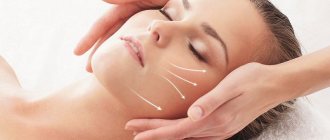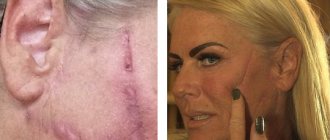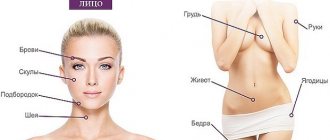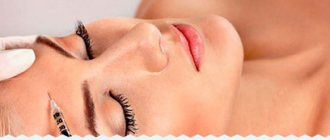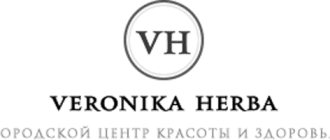Thread lifting is a minimally invasive, effective cosmetic procedure that involves the subcutaneous implantation of materials biocompatible with the human body to reinforce soft tissues. The technique is an excellent alternative to radical surgery, as it is characterized by a minimum of post-procedural complications and short recovery times. To correct age-related changes, different types of threads are used, which are selected individually for each client. The technique demonstrates excellent results for patients aged 35–50 years. The effect of a thread facelift lasts for several years. Cosmetologists at the International Hemostasis Clinic use proven, certified material for thread lifting, guaranteeing each client the most positive results and no side effects.
Types of threads
Facial thread lifting is a minimally invasive anti-aging procedure that uses non-absorbable or absorbable fibers. The first ones remain under the skin after implantation, maintaining a reinforcing effect for 5 to 7 years. Over the course of several months, the absorbable threads gradually dissolve and are removed from the body, and in their place a reliable framework or collagen and connective tissue remains. This frame holds soft structures in a given position, preventing the development of gravitational ptosis. The effect of using self-absorbable threads lasts up to 2 years.
Modern cosmetology clinics use the following types of threads for thread lifting:
- Smooth. They are an absolutely smooth fiber made of silicone, polyurethane, and polyamide. The material does not dissolve and is implanted into the deep layers of the skin, guaranteeing a serious tightening even in cases of severe ptosis. The introduction of smooth threads requires cutting the skin, so the procedure should only be performed by an experienced cosmetologist.
- Mesothreads. They are absorbable threads that dissolve independently 6 months after implantation. The introduction of fibers is carried out with a special blunt-tipped needle, which does not injure the soft tissues, but only pushes them apart. Mesothreads are prescribed to patients aged 35–40 years as a preventive measure for the development of the first age-related changes. The lifting effect lasts 1.5 – 2 years.
- Combined. Lifting threads with notches, made of degradable polypropylene, have 8–11 cones and nodules along their entire length, which self-resolve within 6–8 months after the procedure. In their place, connective tissue is formed, providing a reliable tightening and reinforcing effect.
- Gold. Made from polyglycol coated with gold. Gold threads do not dissolve over time; after implantation, they stimulate the production of collagen, which forms a reliable frame and provides a pronounced lifting effect. The results of the procedure last for 5 – 7 years. After implantation of gold fibers, it is contraindicated to use the services of hardware cosmetology.
Mesothreads: negative reviews, photos
Experienced cosmetologists and plastic surgeons who have the skills to implant reinforcing and lifting threads almost never use ordinary thin mesothreads in their practice. The latter are widely used in cosmetology only because of the simplicity of the procedure, while the installation of reinforcing and lifting threads is too complicated and ideally requires a doctor with a surgical background.
Therefore, most cosmetologists do what they can do (without requiring complex manual skills), namely mesothreads. Therefore, if you want to install lifting threads rather than meso-threads, you should only contact plastic surgery clinics for this. As for reinforcing threads, their installation can be done either traditionally or using the “loop” technique, which can give this type of threads lifting properties. In the latter case, it is probably also better if the threads are installed by a plastic surgeon rather than an ordinary dermatocosmetologist.
Mesothreads: pros and cons... based on experience, only less than 10% of patients are satisfied with the results. Most often you see the following picture: trying to see the result of thread implantation, the patient looks at himself in the mirror with doubt on his face, while the doctor persistently repeats: “Well, you see how good it has become.” Most patients claim that the lifting and rejuvenation effect was either completely absent or was so implicit that it was not worth the money spent.
All you can count on when implanting mesothreads is an improvement in skin color, turgor and skin hydration (and then only if you preferably have a fine-wrinkled type of aging). For comparison, below we have posted photos of patients before and after installation of reinforcing/lifting threads -
Benefits of thread lift
Thread lifting has many advantages:
- painlessness ensured by the use of local anesthesia;
- short rehabilitation period;
- minimal risks of developing post-procedural complications;
- the result can be assessed immediately, over time the effect becomes even stronger;
- low-injury;
- maintaining natural facial expressions;
- compatibility with plastic surgery;
- After the service life has expired, the procedure can be used again without risk to health.
Advantages and disadvantages
The cosmetic method has a number of advantages, but it is important to know the disadvantages of the procedure. A cosmetologist may prescribe thread lifting after assessing the condition of the skin.
Reinforcement can improve lymphatic drainage only in the initial stages; with pronounced age-related changes, an integrated approach is required.
Pros of coggy:
- the result is achieved in 1 procedure;
- the effect lasts from 3 to 5 years;
- the material is not rejected by tissues;
- maintaining natural facial expressions;
- Possibility of use for the face, neck, body;
- has a cumulative effect;
- low morbidity;
- short recovery period;
- combined with other hardware and injection procedures;
- correction requires a minimum number of threads.
Minuses:
- high price;
- some patients feel pain and discomfort;
- the result depends on the doctor’s experience;
- has age restrictions.
Indications for thread face lifting
Thread lifting is prescribed to patients aged 35–50 years as a preventive measure against aging and aging of the skin, as well as gravitational ptosis of soft tissues. Indications for the procedure:
- formation of wrinkles and creases in the forehead, between the eyebrows;
- deep wrinkles in the nasolabial triangle area;
- gravitational ptosis, double chin, change in facial contour;
- drooping of eyebrows, cheeks, cheekbones.
Contraindications to the procedure
Thread reinforcement is not prescribed to patients diagnosed with the following diseases:
- oncology;
- acute infectious and viral processes;
- diseases of the hematopoietic system;
- hormonal, endocrine disorders;
- decompensated diabetes mellitus;
- autoimmune disorders;
- congenital or acquired immunodeficiency;
- cardiovascular pathologies;
- renal, liver, pulmonary failure;
- somatic and mental disorders;
- tendency to form keloid or hypertrophic scars.
The procedure is contraindicated for women during pregnancy, lactation, and menstrual bleeding. Thread lifting is prohibited for patients with individual intolerance to the components of the material.
The principle of operation of face lift with threads
After implantation, connective tissue is formed around the threads, which acts as a framework that eliminates sagging of the soft tissues. In addition, collagen synthesis is activated, due to which noticeable rejuvenation of the skin and smoothing of wrinkles occurs. Even after the fibers are absorbed, the resulting reinforcing frame remains. It provides a pronounced lifting effect and is an excellent prevention of the development of gravitational ptosis and the formation of the first age-related defects.
How does the thread facelift procedure work?
Thread reinforcement includes the following steps:
- Preparation. The procedure is carried out in a cosmetology salon. Before implantation, the specialist cleanses the skin of decorative cosmetics and impurities, then treats the skin with a bactericidal solution that destroys pathogenic microflora that contribute to infection and inflammation.
- Anesthesia. For pain relief, a local anesthetic is mainly used, but sometimes the cosmetologist uses general anesthesia.
- Marking of injection points. The cosmetologist, using a special marker, marks in advance the points where the threads will be inserted.
- Fiber implantation. As soon as the anesthesia takes effect, the specialist, using a special needle or cannula, makes a micro-puncture, implanting threads to a certain depth. The fibers are fixed in the required position and stretched in the direction opposite to the needle.
- Repeated treatment with anesthetic. At the end of the procedure, the insertion sites of the cannulas or needles are re-treated with a bactericidal solution.
- Applying a soothing compress. At the very end, the cosmetologist applies a cold compress to the treatment areas, which relieves inflammation, swelling and prevents the formation of bruises.
At what age should you have a face lift with threads?
The first signs of sagging soft tissues are observed after 30 years. Therefore, starting from this age, you can resort to thread lifting with mesothreads. After 40, it is advisable to reinforce with absorbable fibers, in place of which a reliable frame of connective tissue is formed that holds the soft structures in the required position. Non-absorbable threads are recommended for clients over 50. They effectively eliminate the signs of gravitational ptosis and provide noticeable rejuvenation. After 60, a facelift with threads will not give the desired effect. At this age, it is more advisable to resort to more radical anti-aging procedures.
Opinion of cosmetologists
On forums, cosmetologists share their experience of working with kogi mesothreads.
The review states that if fibrosis forms , it means that low-quality material was used, or the patient has a connective tissue disease.
A participant writes about the effect of mesothreads on a slight overhang of the middle third of the face.
The user asks which threads are best to work with and where to get training.
Recovery period after facelift with threads
Rehabilitation can take from 2 to 6 weeks. It all depends on the type of threads used, the depth of their implantation, and the individual characteristics of the patient’s body. The rules of rehabilitation are simple:
- During the first 2–4 days, try not to touch your face, avoid contact with water, and limit facial movements.
- To eliminate swelling and speed up the resorption of hematomas, it is recommended to apply cold compresses based on decoctions of chamomile, calendula, and sage daily, 2–3 times a day. If you are experiencing severe pain and discomfort, your doctor will prescribe painkillers.
- You are allowed to sleep only on your back, with a high pillow under your head.
- Throughout the entire rehabilitation period, avoid alcoholic beverages, hot, spicy, and salty foods.
- Minimize physical activity.
- Refuse to visit the swimming pool, bathhouse, sauna, solarium.
- Until complete healing, do not use decorative cosmetics and do not resort to cosmetic procedures such as pling, scrubbing, massage.
Mesothreads: price for 2022
For mesothreads for face lifting, the price will depend on the type of thread, as well as their quantity. As we said above, the cheapest cost is the smooth linear type of PDO thread (about 110 rubles for 1 thread). But in the clinic, the price for installing 1 such thread will already be about 900 rubles, but if the patient plans to install a large number of threads, then, based on their quantity, the price of mesothreads can be reduced to approximately 600 rubles for 1 thread.
Threads made from a copolymer of L-lactide with caprolactone will always be a priori more expensive than threads made from PDO, so the cost of 1 thread of the “Aptos Nano Vitis-4” type will be about 1,500 rubles. When installing Screw and Double Screw threads from PDO, you should focus on the same 1,500 rubles for 1 thread. As for GOG type threads, the highest quality ones will have a higher cost and, accordingly, their price usually starts from 2300 rubles for 1 thread. Below you can read reviews of thread lifting with mesothreads.
